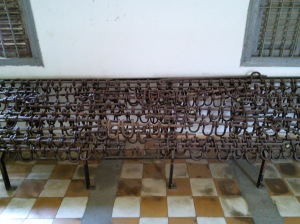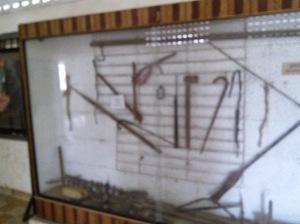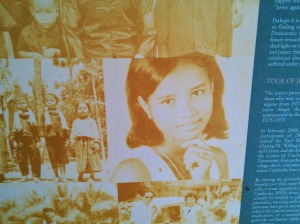The term “killing fields” refers to a number of sites in Cambodia, where large numbers of people were tortured, killed and then buried by the Communist Khmer Rouge regime. I visited one such killing field named Choeung Ek in Phnom Penh. Cambodian journalist, Dith Pran, coined the term “killing fields.” The Khmer Rouge were in power from 1975 to 1979, immediately following the Cambodian civil war (1970-1975). Pol Pot, sometimes referred to as “Cambodia’s Hitler” was responsible for this mass genocide. However, he was never brought to justice – either dying from heart failure or suicide, i.e., no one knows for sure because he was cremated before an autopsy could be performed.
Approximately 2.2 million people were killed and some estimates have the figure as high as 3.4 million. There were 20,000 grave sites researched, many of them mass grave sites. Consequently, no one knows for sure how many people were killed by this regime.
I also visited the Tuol Sleng Genocide Museum. The site is a former high school converted into the notorious Security Prison 21 (S-21). This “house of horrors” was used to torture and kill over 20,000 Cambodians. Tuol Sleng was only one of 150 execution centers in the country.
I’ll be frank – visiting these two sites was a moving, sad and quite a sobering experience. I also was very angry. How could this happen? Why didn’t anyone stop what was happening here? How can people be so cruel to other people? I still have no answers to these and other questions I thought about while there. Do I regret going? Not at all. This is just my opinion, but I think everyone should visit these two sites or other killing fields in Cambodia . . . or, for that matter – any of the holocaust sites in Germany. By bearing witness to what went on here, I think for myself – it is something that had to be done. Walking through both sites, the hair on my arms was raised just thinking about how many people were tortured and killed without a second thought of mercy. I’ll just say it was an unbelievable experience unlike any I have ever had.
Dozens of mass graves are visible above ground, many which have not been excavated yet. Commonly, bones and clothing surface after heavy rainfalls due to the large number of bodies still buried in shallow mass graves. It is not uncommon to run across the bones or teeth of the victims scattered on the surface as one tours the memorial park. If these are found, visitors are asked to notify a memorial park officer or guide.
Upon entering both sites, the tourist conversation quieted to silence. Similarly, these photos – most without captions – tell the story of Choeung Ek and Tuol Sleng.

The “killing tree” which was used by camp guards to kill babies. Specifically, they would take a baby from a mother and smash the baby’s head against this tree. The rationale was to kill the infants so they would not grow up and take revenge for the killing of their parents.

In order to save ammunition, poison and common garden tools such as spades were used to kill the prisoners. Sometimes sharpened bamboo sticks were used as well.

Photo taken of one of the last victims interrogated, tortured, and killed at Tuol Sleng. When the Vietnamese routed the Cambodian capital of Phnom Penh, they found this victim, still chained to the “bed” used for securing a prisoner while he was questioned and tortured.

Photo of another prisoner killed by his fleeing captors only hours before the prison was taken by the Vietnamese.

Gallows used to torture prisoners or kill them outright by hanging. Those are water basins below where prisoners were “dunk” head first via the gallows pole.




























It’s hard to think of anything to say except to think how horrible that man could be so cruel and inhuman to another human being. May God have mercy on their souls.
I agree.
Moving stuff, blade. Thanks for taking the time to put this together. I visited the Dachau camp, just outside Munich, when I was in Germany years ago. It was a smaller camp, not one of the most notorious for numbers of mass murder, but still a gruesome, inhuman place. And, just on the outskirts of Munich, not hidden away somewhere in the middle of a forest, or a desert. The people surrounding HAD to know. That is perhaps the most astounding thing about the depravity that went on there. That the populace had to know, and let it go on, or participated in it as guards or camp workers. 30 years later, Pol Pot did his thing and murdered millions. Now, we have islamic nuts doing mass killings of soldiers or civilians in villages, and enslaving women and children. The thing all these depraved people have in common is a belief in a radical ideology that trumps humanity, not one that seeks to enhance or foster humanity. Radicalized by beliefs that can’t be opposed, other humans become secondary to their way of believing how the world must work…
Tom, it’s ironic that you mentioned Dachau, as it was one of the genocide web sites I researched. Specifically, I wanted to know what visitors to this site felt, as I wanted to see if my feelings were similar to theirs. As you mentioned, I was absolutely shocked to find out that the people living in the town of Dachau feigned ignorance about what went on there. Right. I also read where American soldiers were so upset about this, they marched all the towns people to this concentration camp to observe what went on, as well as forcing them to assist in moving the thousands of dead bodies. Even today, not many visitors stop in the town of Dachau, i.e., still upset and angry with the town for not doing something about the concentration camp located near by. Sad. Thank you for sharing.
Thanks for putting this presentation together, Blade. I learned a lot. You have a lot of talent as a teacher.
It’s always sobering to see what some people can do to their fellow human beings.
Not to get too political (hopefully) but the U.S. had a role in this. The unauthorized bombings of Cambodia during the Vietnam War helped to destabilize Cambodia, which led to the civil war that brought the Khmer Rouge to power.
You’re right Zumiee – the U.S. did destabilize the country via the unauthorized heavy bombing during the tail end of the Vietnam war. Consequently, as you pointed out, it provided an “opening” for the Khmer Rouge to win the civil war and come to power.
On a related note, several years ago singer/songwriter Nanci Griffith wrote and recorded a beautiful song “Heart of Indochine,” after visiting Vietnam with some American veterans of the war.
Here’s the lyrics:
I am on a Riverboat on the Saigon River
Where the music’s too loud
While I try to have my dinner
Stories I’ve been told of 1954
When the bodies washed ashore from that distant war
My friend Michael came in ’68
The bodies still floating
With the dinner boats sailing
Beside all those souls of the American war
(chorus)
Oh, deliver me to the river of souls
In the heart of Indochine
Deliver me to a River at Peace
In this twenty-first century
All those souls that floated free
In these dark war’s waters
All the souls now swim together
The French the Viet Minh
Those American boys
The souls of the Saigon River
At peace in Indochine
I am in a caffe’ in Ho Chi Minh City
My friend Bobby Muller is sitting with me
This traffic is maddening
In his wheelchair he’s napping
I wonder at times, does he walk in his dreams?
Later I walked all the way from Tu Do Street
To the banks of the river
With the dinner boats sailing
Beside all of the souls, of a River in Peace
(chorus)
Hoa binh…Hoa Binh, (“peace” in Vietnamese)
Peace in the Heart of Indochine
Beautiful Zumiee. Later today, I am going to google that song and listen to it. Thank you for sharing my friend.
Hi Blade,
I went there last November, and up till now, I still can recall my feelings on that day. I was really really sad and perplexed at how human can be so cruel, the tortures was so degrading. It seems out of this world, but they were not myths.
Hi Mariam (?),
I hope you are well. Yes, going to these 2 sites was disturbing to say the least. I don’t think anyone can visit the sites and not be affected.
Steven